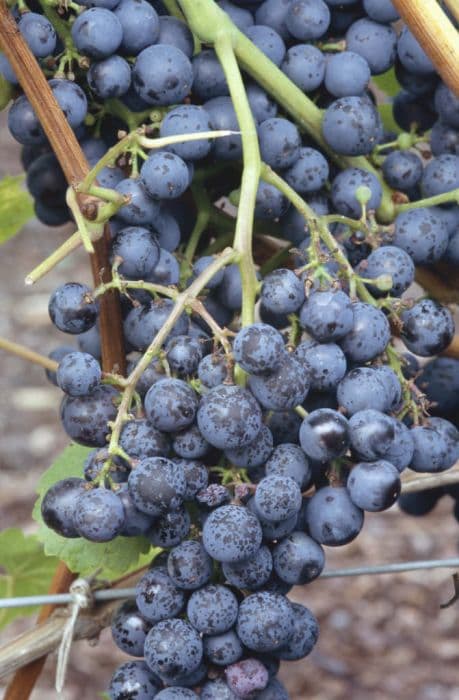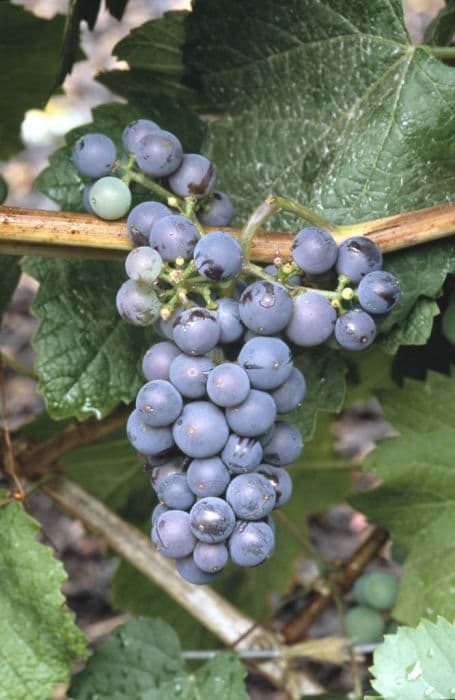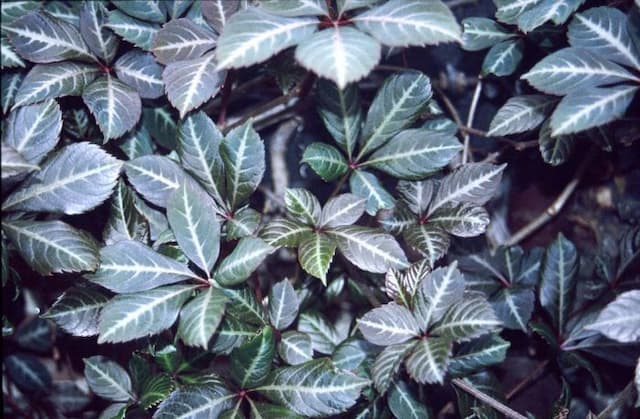Muscat of Alexandria Grape Vitis vinifera 'Muscat of Alexandria' (G/w)

ABOUT
The Muscat of Alexandria grapevine is a variety known for its lush, green foliage that provides a backdrop to its striking fruit clusters. The leaves are broad with a heart-shaped base and sharply toothed margins, exuding a classic vine appearance. As seasons change, the vine can showcase hues that transition into golden yellows or rich reds. The most distinctive feature, however, is its grapes. The fruit bunches hang heavily under the leaves, with each individual grape being relatively large, round, and showing a pale amber or golden hue when fully ripe. These grapes possess a translucent skin that can have a delicate, powdery bloom, contributing to their ethereal appearance. They are known for their sweet, aromatic quality that's highly sought after, especially in the production of dessert wines and table grapes. The vines themselves can be trained and pruned to maintain a desired structure, often supported by trellises or arbors to properly showcase their pendulous fruit clusters.
About this plant
 Names
NamesFamily
Vitaceae
Synonyms
Muscat of Alexandria, Muscatel, Alexandria Grape, Lexia Grape
Common names
Vitis vinifera var. apyrena, Vitis vinifera var. apirena.
 Toxicity
ToxicityTo humans
The grapevine 'Muscat of Alexandria' is generally not toxic to humans when grapes or the ripe fruit are consumed in normal food quantities. However, other parts of the plant, such as the leaves and stems, contain compounds that may cause symptoms if ingested in large amounts. The possible adverse effects can include nausea, vomiting, diarrhea, or abdominal pain. It is essential to note that individuals with specific grape or wine allergies may have allergic reactions to grapes.
To pets
Grapes, including the 'Muscat of Alexandria' variety, are toxic to dogs and potentially other pets as well. Ingestion of grapes can lead to acute kidney failure in dogs. Symptoms of grape poisoning in pets can include vomiting, diarrhea, lethargy, abdominal pain, decreased appetite, and signs of kidney failure such as decreased urine output. It is crucial to seek veterinary attention immediately if a pet ingests grapes.
 Characteristics
CharacteristicsLife cycle
Perennials
Foliage type
Deciduous
Color of leaves
Green
Flower color
Greenish-white
Height
10-20 feet (3-6 meters)
Spread
10-20 feet (3-6 meters)
Plant type
Climber
Hardiness zones
7
Native area
Mediterranean
Benefits
 General Benefits
General Benefits- Edible Fruits: Produces sweet grapes commonly used for eating fresh, making raisins, or for the production of muscat wines.
- Habitat for Wildlife: Can provide food and shelter for birds and other wildlife in the garden.
- Erosion Control: When planted on slopes or banks, the vine's root system can help stabilize soil and prevent erosion.
- Aesthetic Appeal: Adds visual interest to gardens with its lush foliage and clusters of grapes, enhancing landscape beauty.
- Shade Provider: With suitable support, it can grow to cover pergolas or arbors, offering a natural shade canopy.
- Cultural Significance: Has historical importance in many cultures for its use in winemaking and traditional cuisines.
- Pollinator Attraction: Flowers attract bees and beneficial insects, supporting the local ecosystem.
- Economic Value: Important crop in the agriculture sector due to its demand in the food and beverage industry.
 Medical Properties
Medical Properties- Antioxidant effects: Muscat of Alexandria grapes contain various antioxidants like resveratrol, which can help protect cells from damage.
- Cardiovascular health: Consuming grapes from the Muscat of Alexandria plant may contribute to heart health due to the presence of polyphenols which can improve circulation and reduce inflammation.
- Anti-inflammatory properties: The compounds found in these grapes can help reduce inflammation in the body, potentially benefiting individuals with chronic inflammatory conditions.
- Glycemic control: Some studies suggest that grape consumption might aid in blood sugar regulation, although this is not specific to the Muscat of Alexandria variety.
 Air-purifying Qualities
Air-purifying QualitiesThis plant is not specifically known for air purifying qualities.
 Other Uses
Other Uses- Grapes from Muscat of Alexandria can be dried to produce raisins, which are a sweet and energy-dense snack enjoyed worldwide.
- The vines of the grape plant can be trained over arbors or pergolas to provide shade and create a picturesque garden feature.
- Young grapevine shoots can be used in culinary dishes; they're often pickled and used as a delicacy in certain cuisines.
- The sap of the grapevine, also known as 'tears of the vine', can be collected and used as a natural sweetener or in traditional remedies.
- Grape leaves can be harvested and used for culinary purposes, most notably in the dish dolma, where they're stuffed with various fillings.
- Wood from old grapevines can be repurposed as material for crafting furniture or decorative items, offering a unique aesthetic due to the vine's twisting patterns.
- Pressed grape seeds from Muscat of Alexandria produce grape seed oil, which is used for cooking and cosmetics due to its high antioxidant content.
- The grape pulp, skin, and seeds that are byproducts of winemaking can be composted to enrich soil, returning nutrients back to the earth.
- Floral essences derived from Muscat grapes are sometimes used in perfumery for their sweet and fruity notes.
- Grapevine ash, produced by burning pruned branches, can be used as a natural fertilizer or in soap making due to its potash content.
Interesting Facts
 Feng Shui
Feng ShuiThe grapevine is not used in Feng Shui practice.
 Zodiac Sign Compitability
Zodiac Sign CompitabilityThe grapevine is not used in astrology practice.
 Plant Symbolism
Plant Symbolism- Fertility and Abundance: The Grape, featured in numerous ancient cultures, symbolizes fertility due to its propensity for producing fruit in large clusters, representing plenty and abundance.
- Vitality and Life: As a plant that produces grapes used to make wine, historically associated with celebrations and vitality, the Grape signifies life and the life-giving elements of the earth.
- Prosperity: The Grape vine, often abundant with fruit, is a symbol of material and spiritual wealth, suggesting a prosperous life.
- Transformation: Since grapes undergo a significant transformation from fruit to wine, they symbolize change and the process of maturation or spiritual development.
- Enjoyment and Indulgence: The Grape is linked to Dionysus/Bacchus, the gods of wine, representing enjoyment, festivity, and a sense of indulgence in the pleasures of life.
- Eternity: The durability and perennial nature of the Grape vine, which can live and produce fruit for decades, make it a symbol of eternity and enduring life force.
 Water
WaterMuscadine grapes require thorough watering, especially during their first few growing seasons to establish a deep and extensive root system. Watering should be done once a week, providing the grapevines with approximately 1 to 1.5 gallons of water each time. During periods of drought or extreme heat, it may be necessary to increase the frequency of watering to twice per week. It is important to avoid overwatering, as this can lead to root rot and other diseases. During the dormant season, reduce watering since the plant's water needs decrease.
 Light
LightMuscadine grapes require full sun to produce the best fruit. This means choosing a spot that receives at least 6 to 8 hours of direct sunlight daily. Adequate sunlight is crucial for the development of sugar within the fruits, which affects the overall taste and quality of the grapes.
 Temperature
TemperatureMuscadine grapes thrive in a temperature range between 75°F and 85°F. These grapes can tolerate a minimum temperature of about 0°F and a maximum temperature above 100°F. However, they prefer hot and humid climates and may require winter protection if temperatures consistently fall below 20°F.
 Pruning
PruningPruning is essential for muscadine grapes to manage vine size, improve sun exposure and air circulation, and encourage the development of fruit-bearing shoots. Pruning should be done in late winter or early spring before new growth begins. Remove all but a few new canes from the previous year's growth since these canes will produce the current year's fruit. Also, remove any diseased or damaged wood and thin out crowded areas.
 Cleaning
CleaningAs needed
 Soil
SoilMuscat grapevines thrive in well-draining, loamy soil with a pH around 5.5 to 6.5. A mix of two parts loam, one part sand or perlite, and one part organic compost provides the nutrients and aeration they need for healthy growth.
 Repotting
RepottingMuscat grapevines, when grown in containers, should be repotted every 2 to 3 years to prevent root binding and to replenish nutrients in the soil. During the dormant season, usually late winter, is the best time to repot these vines.
 Humidity & Misting
Humidity & MistingMuscat grapes prefer a moderate level of humidity, around 40-60%. These grapevines typically thrive outdoors where the natural humidity is adequate, but they should not be exposed to overly wet or dry conditions for prolonged periods.
 Suitable locations
Suitable locationsIndoor
Provide Muscat grapes with sunlight, warmth, and a sturdy trellis.
Outdoor
Ensure full sun, good airflow, and trellis support for vines.
Hardiness zone
7-10 USDA
 Life cycle
Life cycle'Muscat of Alexandria', a variety of the common grapevine, begins its life cycle with seed germination, although commercial vines are typically propagated via cuttings to maintain cultivar traits. After root establishment, the vine enters a vegetative stage characterized by rapid shoot and leaf growth. Upon reaching maturity, which can take several years, it enters the flowering stage in late spring or early summer; here, self-pollination usually occurs, enabling fruit development. The grape clusters ripen throughout the summer, turning sweet and aromatic as they reach the harvest stage by late summer or early fall. Following harvest, the vine enters a dormant phase in winter, conserving energy and resources. In the following spring, the cycle resumes with new vegetative growth, continuing the perennial life cycle of 'Muscat of Alexandria'.
 Propogation
PropogationPropogation time
Spring to Summer
Propogation: The most popular method of propagating the Muscat of Alexandria grapevine is via hardwood cuttings. This is typically done during the dormant season, in late winter or early spring, just before the buds begin to swell. Cuttings should be about 12 inches (30 centimeters) long, with several buds, and be taken from healthy, one-year-old wood. After cutting, the lower end is often dipped in a rooting hormone to encourage root growth and then planted in a well-drained soil mix, with two-thirds of the cutting buried beneath the soil surface. It is important to keep the soil moist but not waterlogged to prevent rot. The cuttings will develop roots and can be transferred to their permanent location in the vineyard once they are well established, which usually takes several months.









